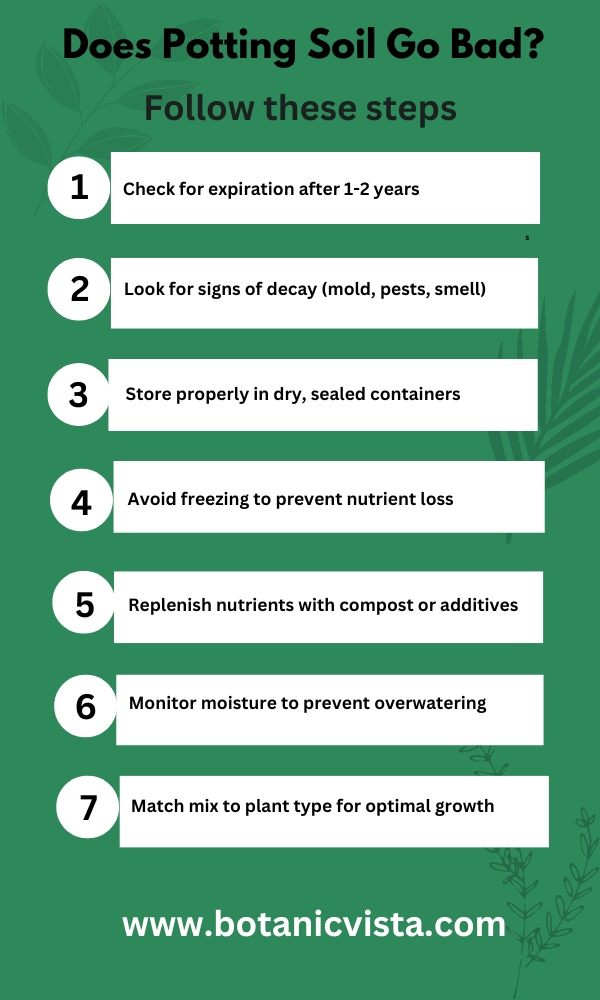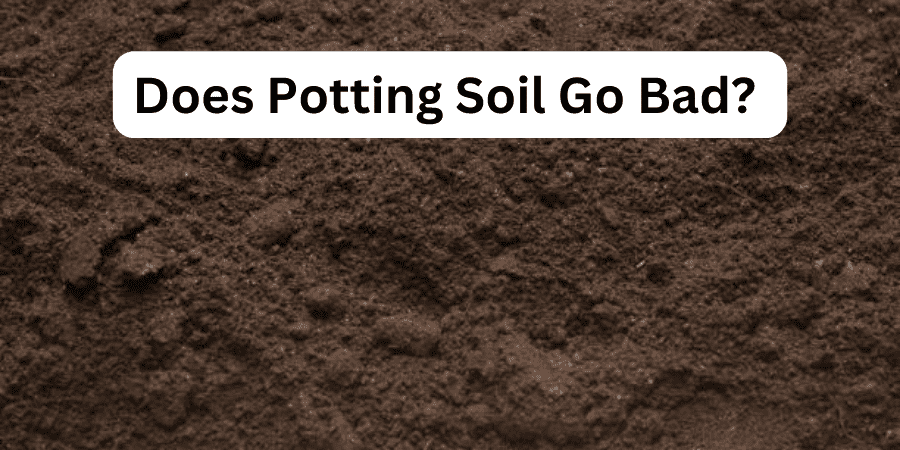Last Updated on October 14, 2024 by Jocelyn
Does potting soil go bad? Yes, it can. Over time, materials like peat, coconut coir, perlite, and vermiculite break down, causing the soil to lose nutrients and become compact. This makes it less effective for your plants, especially in containers, where loose, well-drained soil is essential for healthy growth.
One alternative to old potting soil is to revive it by mixing in fresh compost, calcined clay, or organic materials like bark or rice hulls. These ingredients can bring life back to your soil by adding microbes and nutrients that are essential for a healthy growing environment.
Some gardeners also like to use recycled or eco-friendly options, such as coconut coir or wool tufts. These products are not only good for the environment but also provide a cost-effective way to keep your plants healthy and blooming.
In my garden, I noticed the old potting soil wasn’t doing much for my plants anymore. I decided to mix in some fresh compost and peat-based materials, and it made a real difference. The plants started blooming again, and I ended up with a good harvest.
In this article, we’ll discuss how potting soil changes over time and what steps you can take to keep it healthy for your plants.

Table of Contents
ToggleUnderstanding Potting Soil: Composition and Lifespan
Potting soil, while generally durable, can degrade over time. Factors like moisture, temperature, and exposure to air contribute to its decline. Over time, it can become compacted or lose its nutrients, impacting its effectiveness for plant growth. Potting soil typically has a lifespan of 6 months to 1 year, depending on its usage and care.
What is Potting Soil?
Potting soil is a special kind of growing medium used for houseplants and potted plants. Unlike regular soil, it’s scientifically designed to help plant roots grow strong by holding the right amount of water and oxygen. It also helps with drainage so plants don’t get too wet.
What is Potting Soil Made Of?
Potting soil is a mix of different components like coconut coir, compost, peat moss, and perlite. These materials help with moisture retention, and aeration, and provide essential nutrients for healthy plant growth.
Does Potting Soil Go Bad if Unopened?
Yes, unopened potting soil can still go bad. Sometimes, you might notice mold or a bad smell when you finally open it, which means the soil has deteriorated. For the best results, it’s better to use fresh potting soil rather than risking your plants’ health with old, unopened soil.
Does Potting Soil Go Bad if It Freezes?
Potting soil can get different when it freezes, but it doesn’t always go bad. Freezing can make the soil lose some important stuff that plants need. But, freezing also helps by killing bugs and germs that might hurt your plants.
After the potting soil thaws, it might feel dry or crumbly. You can still use it, but adding some new soil or compost can make it better. This helps your plants grow strong and healthy.
Even if your potting soil freezes, it can still be useful. Just check it before using, and if it looks too dry, mix in something fresh to help your plants grow well.
Learn how potting soil quality impacts your fertilizer and tomato plants:
- Leggy Tomato Plants – Quick Solutions to Save Your Crop!
- Does Fertilizer Go Bad? Here’s What You Need to Know!
Recognizing Bad Potting Soil
Potting soil can show several signs when it has gone bad. You might notice an unpleasant odor, poor drainage, or even mold growth. These indicators suggest that the soil is no longer healthy for your plants and may need to be replaced to ensure optimal plant growth.
| Signs | Description |
| Unpleasant Odor | If your potting soil has a musty or moldy smell, it might be decomposing and infested with fungal organisms. |
| Crusty Surface | A crust on the soil surface means it’s dry and could be hydrophobic, preventing water absorption. |
| Compacted Soil | Soil that is crumbling, compact, or cracking needs renewal because it’s lost its airy texture. |
| Pest Infestation | Look for bugs, gnats, and other insects. These pests lay egg larvae that damage the soil. |
| Poor Drainage | If water trickles or stays standing after watering, the soil may have poor drainage and become waterlogged. |
| Mold Growth | White or dark mold on the soil means it’s unhealthy and possibly infested with fungal spores. |
| Discolored Plants | Yellowing or discolored leaves indicate the soil has degraded and is no longer providing enough nourishment. |
| Weak Plant Growth | Plants with stunted growth or dropping leaves may need to be repotted into fresh soil. |
How to Revive and Reuse Old Potting Soil
Reviving old potting soil starts with assessing its condition. If the soil feels compact or dense and has a bad smell, it’s likely that it needs some attention. Begin by removing any roots, debris, or material left over from previous plants, as these can carry disease and attract pests.
To make sure the soil is safe for new plants, sterilize it by spreading it on cookie sheets and heating it in an oven at a low temperature. Alternatively, you can use solarization by placing the soil on a tarp in the sun, allowing the UV rays to eliminate harmful pathogens.
After sterilizing, enrich the soil by adding organic matter such as compost and beneficial microorganisms like humic acid and kelp. This helps replenish nutrients and brings the soil back to life.
Check the pH levels and adjust with lime or sulfur if necessary, ensuring that the soil has an adequate supply of primary nutrients like nitrogen, phosphorus, and potassium, as well as secondary nutrients like calcium and magnesium.
To improve the soil’s structure, mix in biochar or sand to enhance aeration and drainage, promoting healthy root growth. Finally, add a quality fertilizer mix to nourish the soil further.
How to Reuse Old Potting Soil
Reusing old potting soil is a great way to be cost-effective and sustainable in your gardening. Instead of throwing away used soil, you can breathe new life into it with a few simple steps.
- Test the Soil
Before reusing the revived soil, it’s important to check its condition. If the soil lacks nutrients, enrich it with additional organic matter or compost to restore its fertility.
- Blend with Fresh Soil
For optimal results, mix the revived soil with some fresh potting soil. This combination helps keep the soil airy, balanced, and well-prepared to support new plants. Avoid using peat-based mixes if possible, as they can cause the soil to become overly compact.
- Regularly Feed and Maintain
Keeping a regular feeding schedule is key to maintaining the soil’s health and vitality. Periodically feed the soil with a soluble food powder mixed with water, providing it with the nutrients it needs to support plant growth.
Storage of Potting Soil
Storing your potting soil properly is essential to maintain its quality and keep it ready for your next planting project. Follow these steps to store your potting soil effectively:
1. Choose the Right Storage Area
Select a cool place like a potting shed, garage, or basement. Avoid areas with direct sunlight and temperature fluctuations.
2. Use Airtight Containers
For both opened and unopened potting soil, store it in a clean airtight container such as plastic totes or buckets. This helps keep moisture, oxygen, and pests like fruit flies out.
3. Seal Opened Bags Properly
If you have opened potting soil, ensure you reseal the bag tightly after each use. You can also transfer the soil to an airtight potting soil container to preserve its correct moisture levels and prevent mold growth.
4. Avoid Excess Moisture
Moisture can degrade the soil and encourage mushrooms and fungi to grow. Keep the soil in a dry place to prevent this. Check the soil occasionally for any signs of excess moisture.
5. Check for Pests and Mold
Before storing the soil, inspect it for old plant matter, mold, and unwanted diseases. This step is important, especially when repurposing old potting soil.
6. Label Your Containers
Clearly label your airtight containers or soil bags with the date and type of soil. This helps you keep track of the soil’s lifespan and allows you to use the oldest soil first.
7. Monitor Soil Quality Regularly
Periodically check the soil quality. Look for signs of soil degradation like mold, unpleasant odor, or pests. If any issues are detected, consider discarding the soil or treating it before use.
Choosing the Right Potting Soil for Different Plants
Choosing the right potting soil is key to the healthy growth of your plants. Each plant has specific requirements, and using the appropriate potting mix helps provide the right balance of nutrients, drainage, and structure they need to grow well.
Houseplants
For houseplants, it’s important to use an airy mix that keeps the soil light and prevents waterlogged roots. A blend of peat moss, perlite, and coconut coir helps maintain healthy growth. Adding vermiculite and compost provides the essential nutrients that support the overall growth of houseplants.
Cacti and Succulents
Cacti and succulents do well in a fast-draining succulent mix. This type of soil typically contains sand, perlite, and bark, which helps prevent waterlogged roots. These plants prefer a well-draining soil that mimics their natural growing conditions, promoting strong and healthy root growth.
Acid-Loving Plants
Acid-loving plants like azaleas, rhododendrons, and blueberries require acidic soil. Using an acidic potting mix or incorporating slow-release fertilizers designed for these plants can promote better growth. Orchid mix or rhododendron mix are excellent choices to meet their specific dietary needs.
Seedlings and Vegetables
For seedlings and vegetables, a seed starting mix or a vegetable mix is ideal. These mixes are nutrient-rich and light, allowing seeds to sprout easily. Ingredients like perlite and coconut coir create a solid foundation for root growth. Adding compost further enriches the soil, providing the necessary nutrients for a successful garden.
FAQ’s
Q: How Do I Know if My Potting Soil Is Still Good?
A: Check if your potting soil is compacted or has a moldy odor. If you notice a white fungal layer or small insects like fungus gnats, the soil may be infested and not good to use anymore.
Q: Is 2 Year Old Potting Soil Still Good?
A: Two-year-old potting soil can lose its effectiveness, as nutrients may deplete and compaction can occur. If stored properly, it might still work, but refreshing it periodically is essential for healthy plants.
Q: Can I Use Expired Potting Soil?
A: Potting soil that’s stored properly can last for years, but it might degrade and lose nutrients over time. Mixing new soil with old soil can help improve results.
Q: Why Shouldn’t You Touch Potting Mix?
A: Touching potting mix can be risky. Bacteria like Legionella longbeachae may live in the dust of contaminated soil. When you breathe in this dust, you could get a lung infection called Legionnaires’ disease from inhalation of the harmful particles.
Q: What Is the Best Soil for Pots and Containers?
A: Use a potting mix with peat, sphagnum moss, and compost for pots. Add perlite or vermiculite for drainage. This mix provides essential nutrients and organic materials for healthy plants.
Conclusion
Potting soil can lose its value and nutritional content over time. Old soil might become dense and less effective for plants to grow. It’s important to regularly check your soil’s condition; if it feels hard or dry, it may have expired and needs replacing. Using fresh potting soil can provide your plants with the nutritional boost they need to stay healthy and revive their growth. Taking this proactive step will help ensure your garden continues to flourish.

